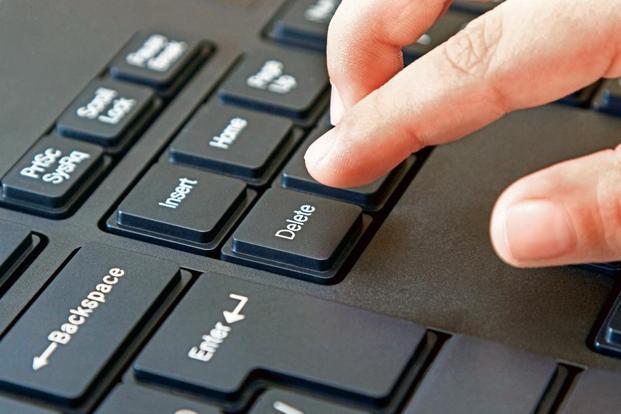A 101 on removing your personal data from the Internet. But be warned: it’s a painful exercise
Had enough of selfies, tweets, posts and searches? Tired of bots tracking and predicting every move of yours? If you want to get back to being anonymous, here’s how you can systematically delete personal information from the World Wide Web.
STEP 1: Target social media
Posts, photos, thoughts, tumblers, tweets…. We have all posted endless numbers of things online on various social media accounts. Start by deleting all these accounts: Facebook, Google Plus, LinkedIn, Instagram, Pinterest, YouTube. All of them have the option to deactivate an account. If you are still not able to figure out how to delete a particular social media account, head to DeleteYourAccount.com, which tells you the process for 34 social media accounts.
STEP 2: Get hold of other accounts
Remember that shopping site where you created an account because they had an offer you just couldn’t resist? Or that food app which had promised a free dinner if you signed up with them? Even that dating site you visited once? And that game you played for a day and then forgot about? It’s time to go through your emails and list all the obscure accounts you’ve created over the years. If you’re not sure, simply search for your name and the usernames you use in Google, Bing, Yahoo and other search engines. You may have forgotten the passwords or the account could have been deactivated simply because you haven’t used it in a long time.
But if you really want to wipe that slate clean, you will need to reset the password, sign in to reactivate the account, and then proceed to delete it. Most of the online companies allow you to deactivate, but there’s no guarantee that all of them will actually delete all the data they have collected about you, says Thejesh G.N., a Bengaluru-based technologist and co-founder of DataMeet, a community of open-data enthusiasts. “Unfortunately, in India we don’t have any legal option to demand that the personal data be deleted by the online or telecommunication company,” he says. This is why the other steps that follow are important.
STEP 3: Unsubscribe mailing lists
There was a time before social media when we used to subscribe to the newsletters of different websites. You might still be old-fashioned and get emails from Google and Yahoo groups and various forums, as well as from associations and sundry accounts that you have subscribed to. Go through your Inbox, Spam and Junk folders and methodically unsubscribe from each of these groups.
STEP 4: Dumb down your phone
Every app that you downloaded on your smartphone collects some kind of data about you. “Apps send off location, geo-tags, your search patterns, contacts, and sometimes even read your messages,” says Rakshit Tandon, cyber-security consultant with the Internet and Mobile Association of India, who does workshops with law-enforcement agencies on Internet security.
The ideal way is to remove the Internet factor—switch off 2G, 3G and 4G and use your smartphone only to make calls. If you don’t want to switch off the World Wide Web completely, start by controlling the apps. Uninstall the apps you don’t require and haven’t used for a while. Then head to the app websites and delete your personal account from there. Simply uninstalling the app won’t delete your personal information from the company’s servers.
If you want to make sure personal data is removed by the app owners, email the webmasters of the companies running these apps and ask them to erase your personal content. If you don’t want to uninstall the app from the phone, make sure you know what permissions each of these apps is using. In most phones, you can head to App Settings and you’ll know what all you’ve said yes to. Switch off the permissions you don’t want to give, or uninstall if the app refuses to work without these.
STEP 5: Remove search engine results
Would you want your name to vanish from search engine results? If the answer is yes, then most of the search engines let you remove certain links—which come up when you search your name—that might be harming your reputation. However, if the mention is not harming your reputation in any way or isn’t a copyright infringement or harassment, as decided by the search engine company, it might be hard to get a search engine to remove links about you. In that case, click on each of the links, head to the individual websites that are using your name in news, mentions, or listings, and email each webmaster of these websites, requesting them to remove mentions about you from their sites.
STEP 6: Become browser-anonymous
When you next want to go online and search, make sure you do it anonymously. By default, most browsers track your activity. Opt for Incognito modes in the browser. Enable Privacy Badger (www.eff.org/privacybadger; free for Chrome and Firefox) to make sure cookies are disabled and third-party trackers are not secretly seeing what you check online. Install AdBlock Plus (Adblockplus.org; free on Firefox, Chrome and Safari) to block banner ads, pop-up ads, tracking cookies and scripts.
Another thing you can do is make sure you have opted out of Google Analytics tracking. Go to Tools.google.com/dlpage/gaoptout and opt out. If you like anonymity but do want to browse, consider the open-source anonymous Tor Project (Torproject.org), which lets you browse online and communicate with others without tracking you.
STEP 7: Reinvent
Some online companies don’t delete information on their servers even if you delete your account with them. In that case, give misleading information, like the wrong birth date, name, surname, age, profile photos, etc.
Complete article at livemint.com



